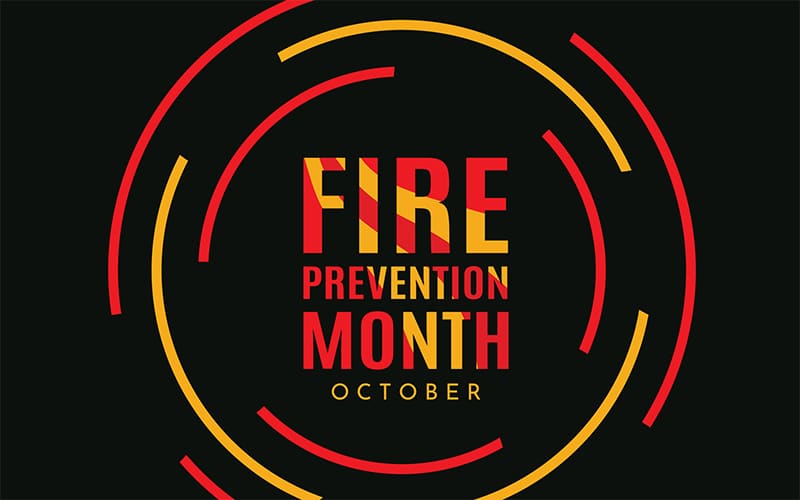National Fire Prevention Month has been commemorated every October for more than 100 years.
This year, the annual observance dedicated to fire awareness and safety is especially significant to scrap metal recyclers given the rise in scrap yard fires and efforts to determine the cause. From coast to coast in the United States and Canada, high-profile scrap yard fires have made headlines over the past year.
In April, the U.S. National Transportation Safety Board (NTSB) released a report on its investigation of a large scrap metal barge fire off the coast of New Jersey in May 2022. The NTSB could not determine an exact cause of the fire but noted that it was not an isolated incident. The report stated, “Although scrap metal cargo is typically non-hazardous and poses low fire risk, there have been several recent fires.”
Lithium-ion batteries and scrap metal recycling fires
The report listed some probable scrap metal fire causes such as a spark between metal objects or residual amounts of flammable liquids seeping out of scrapped cars. These sparks can ignite and spread to flammable material mixed with scrap metal, like bits of upholstery, plastic or rubber clinging to metal in automotive scrap. The report notes that these hazards have always been present in scrap metal, but there is a new and more serious danger mixed with scrap metal now and that is discarded lithium-ion batteries which make their way into the scrap stream. Loose lithium-ion batteries are not permitted in checked luggage on commercial airlines, for example, because of the significant fire risk they pose.
According to investigators and industry experts, one of the main problems is that these batteries are in an increasing number of consumer goods and electronic waste. Most people are familiar with the rechargeable batteries in their laptops, smart phones, and tablets, but these small batteries are also in everything from musical greeting cards to smart watches, earbuds, and electric scooters. Unlike traditional alkaline batteries, lithium-ion batteries are capable of spontaneously igniting from overheating. This is because they pack a lot of energy into a small package, having the highest energy density of any battery technology. They deliver a voltage that is three times higher than other batteries. Generating all the electricity causes heat that can lead to fires or explosions when damaged through an uncontrolled chemical reaction called “thermal runaway.”
When these batteries embedded in a consumer product make their way into a metal recycling plant, they can get into a stream of metal headed to a shredder or crushed under heavy equipment moving scrap. Breaking open or crushing the battery will cause it to ignite. Once a fire has started, it can be a greater challenge to extinguish, because a lithium-ion battery releases a flammable vapor that is toxic, and which essentially produces its own fuel. Scrap yard fires like these can cost hundreds of thousands of dollars to put out, and it can take fire departments days to successfully stop such a fire.
Industry and insurance experts list the following things you should know about lithium battery fires:
- Such fires usually occur after a battery has been damaged causing a rupture in the membrane that separates the chemicals inside, sparking a self-perpetuating fire.
- Small lithium-ion fires can be extinguished with special extinguishers. Although they are labeled for use on metal fires, Class D fire extinguishers do not work on lithium-ion battery fires. This is because the batteries do not really contain lithium metal.
- Lithium-ion batteries are classified as a Class B flammable liquid fire, so an ABC or BC fire extinguisher would be appropriate.
- Water can also be effective in dampening lithium-ion fires because the water reduces the heat created by the chemical reaction.
- Those at risk of exposure to such fires should implement a plan with the local fire department and develop an action plan with staff.
- Maintain an automatic suppression system if possible.
- Avoid parking or leaving equipment near a potential heat source.
- Install thermal sensors if possible.
- Train employees to use equipment on hand to contain fires.
- Have a working automatic sprinkler system and even manually operable roof vents to let heat escape.
- Maintain good basic housekeeping, limiting the amount of debris and dust buildup that could act as fuel.
Other causes of increased scrap metal fires
Lithium-ion batteries are not the only reason for increases in scrap yard fires. Additional reasons for increasing yard fires include stockpiling of scrap in yards due to changing market conditions, and dryer and hotter weather. The Occupational Safety and Health Administration (OSHA) in 2008 published “Guidance for the Identification and Control of Safety and Health Hazards in Metal Scrap Recycling” that included guidance on reducing yard fires. OSHA has additional resources regarding yard fires on their website today as does the National Safety Council.
For many years, industry associations and government agencies have been offering guidance to help reduce the number of yard fires. Recognizing the magnitude of the problem, the Environmental Protection Agency (EPA) in 2021 published “An Analysis of Lithium-Ion Battery Fires in Waste Management and Recycling.” The study summarizes the magnitude of this problem and outlines steps needed for industry and consumers to address the hazard. The Institute of Scrap Recycling Industries (ISRI) has a Fire Management webpage which includes many resources including a fire prevention and management plan and a series of fire prevention videos.
What industry and consumers can do
Some recyclers and municipal waste facilities have invested in fire monitoring systems which remotely detect increases in heat or “thermal detection” and can also remotely deploy a cooling agent to put out fires. These companies advocate using both technology and improved processes to cut down fire risk.
In addition to industry actions to reduce fires, individual consumers can take steps to improve fire prevention at recycling plants by disposing of their recyclables in the appropriate way. Consumers should never place electronics which include lithium-ion batteries in curbside recycling. Instead, take electronic waste to designated recycling centers. Many stores like Lowes or Home Depot offer periodic collection of electronic waste. Additionally, consumers should recycle the right items in the right way, making sure bottles, cans, paper, and cardboard are clean and empty. Foods and liquids should be kept out of recycling. Keep plastic bags out of recycling and make sure dangerous items like propane tanks, cans of paint and all electronics are kept out of recycling.
With increased awareness, consumers and companies can reduce fires at scrap metal recycling plants through fire protection plans, employee training, public education, and investment in fire detection technologies. If both industry and individuals take action to reduce scrap yard fires, scrap metal recycling can continue to keep material out of landfills and allow for its reuse in a way that helps the environment and the economy while keeping everyone safe.
About ScrapWare Corporation: Since 1989, Rockville, Maryland-based ScrapWare Corporation has been the software of choice for the recycling industry. Its ease of installation and simplicity saves users time and money while helping them achieve compliance and maintain accurate business insights. With state-of-the-art functionality that‘s tailored to each organization’s unique requirements, ScrapWare is an advanced dynamic software solution that alleviates the most pressing recycling industry worries. For more information, please call (301) 517-8500 or visit https://www.scrapware.com/.

